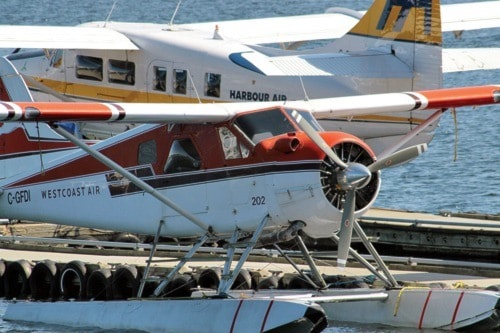Nanaimo floatplane operators are already ahead of safety recommendations issued Thursday by the federal Transportation Safety Board.
The recommendations, which suggest a series of “common-sense fixes” to make commercial floatplane travel safer, are the result of a 16-month investigation into a Nov. 29, 2009 crash of a de Havilland Beaver aircraft operated by Seair Seaplanes off Saturna Island that killed six of eight passengers.
“We want to give passengers every chance to get out quickly and stay afloat until help arrives,” said Wendy Tadros, chairwoman of the TSB, in a statement with the report’s release Thursday.
“We are calling for doors and windows that come off easily after a crash and for everyone to wear a personal flotation device. These two recommendations are simple in concept, common sense, really,” she added.
Lyle Soetaert, president of the Floatplane Operators Association, said his group’s 55 members – including Nanaimo-based Harbour Air and West Coast Air, as well as Seair – have already embraced safety improvements like the installation of pop-out windows and more user-friendly door handles.
Earlier last week, Harbour Air became the first operator in Canada to install a new safety handle in its de Havilland DHC-2 Beaver.
“The industry has been very proactive,” Soetaert said Friday. “This is something we can do better and want to do better.”
Harbour Air and Westcoast Air completed installing the pop-out windows on the roughly 20 Beaver aircraft in its 54-plane fleet last month and has the new door latches – which are similar to car door handles – on seven or eight planes so far, said Greg McDougall, Harbour Air CEO. The door-latch kits alone cost about $7,000 each.
Other safety improvements from Harbour Air and Westcoast Air include additional pilot training on passengers exiting a floatplane in an emergency and enhanced safety briefings for passengers. Plans are also underway for safety videos for passengers in their terminal and onboard the plane.
“We want to encompass all the safety information, but also make them a little bit entertaining so people will watch them,” McDougall said. “We’re really just reinforcing all the safety information.”
Peter Clarke, Seair CEO, said his company has made similar strides.
Pop-out windows were installed as soon as they became available and Seair is moving ahead with new door latches, Clarke said. It’s also looking to replace the Beavers with newer planes that incorporate the improvements.
But floatplane operators are more hesitant about making passengers wear personal flotation devices, which are already carried aboard planes. Soetaert said more research is needed to determine how PFDs can be used in a safe and effective method while on board.
“The association welcomes the recommendation of having a life vest, but we need to determine the best way to use it inside the aircraft,” he said.
The use of a standard PFD could reduce mobility and make exiting the aircraft more difficult in the event of an emergency, he said.
Those concerns are echoed by Clarke, who said Seair has stepped up passenger briefings regarding the location and operation of life jackets, and is in favour of the TSB recommendation if a suitable PFD is approved.
But McDougall noted there is no Transport Canada-approved PFD for multiple and frequent use in floatplanes. And since Harbour Air flies more than 400,000 people a year, inflatable vests would incur serious wear and tear.
“We’re not saying never ... but we think it needs a lot more study,” he said.
While suggesting that Transport Canada needs to fully study whether wearing life jackets in flight will save lives, Harbour Air is taking the lead by already initiating investigation of potential PFDs for use in floatplanes, with a preliminary meeting with Mustang already held, McDougall said.
“We lead the industry, so we’re going to look at it,” he said. “We want to make sure ... that it’s the right type of device.”
The TSB has made similar recommendations regarding PFDs before, but they were never implemented by Transport Canada.
Transport Canada has 90 days to consider and respond to the TSB recommendations.
Only two of the province’s 55 commercial floatplane operators require that passengers wear personal flotation devices while on board. Neither company serves Nanaimo.
